Investment Strategies 2011, What to Buy and Sell
Stock-Markets / Investing 2011 Jan 25, 2011 - 02:44 AM GMTBy: John_Mauldin
 This week I am really delighted to be able to give you a condensed version of Gary Shilling's latest INSIGHT newsletter for your Outside the Box. Each month I really look forward to getting Gary's latest thoughts on the economy and investing. In 2009 in his forecast issue he suggested 13 investment ideas, all of which were profitable by the end of the year. Last year he gave us 16 which the large majority hit the mark. It is not unusual for Gary to give us over 75 charts and tables in his monthly letters along with his commentary, which makes his thinking unusually clear and accessible. Gary was among the first to point out the problems with the subprime market and predict the housing and credit crises. His track record in this decade has been quite good. I want to thank Gary and his associate Fred Rossi for allowing us to view this smaller version of his latest letter, where he gives us 18 investable strategies for 2011.
This week I am really delighted to be able to give you a condensed version of Gary Shilling's latest INSIGHT newsletter for your Outside the Box. Each month I really look forward to getting Gary's latest thoughts on the economy and investing. In 2009 in his forecast issue he suggested 13 investment ideas, all of which were profitable by the end of the year. Last year he gave us 16 which the large majority hit the mark. It is not unusual for Gary to give us over 75 charts and tables in his monthly letters along with his commentary, which makes his thinking unusually clear and accessible. Gary was among the first to point out the problems with the subprime market and predict the housing and credit crises. His track record in this decade has been quite good. I want to thank Gary and his associate Fred Rossi for allowing us to view this smaller version of his latest letter, where he gives us 18 investable strategies for 2011.
 If you are interested in subscribing to his letter, his web site is down being re-designed, but you can write for more information at insight@agaryshilling.com. If you want to subscribe (for $275), you can call 888-346-7444. Tell them that you read about it in Outside the Box and you will get the full 2011 forecast with price targets, plus an extra issue with his 2012 forecast (of course, that one will not come out until the end of the year. Gary is good but not that good!) I trust you are enjoying your week. And enjoy this week's Outside the Box....
If you are interested in subscribing to his letter, his web site is down being re-designed, but you can write for more information at insight@agaryshilling.com. If you want to subscribe (for $275), you can call 888-346-7444. Tell them that you read about it in Outside the Box and you will get the full 2011 forecast with price targets, plus an extra issue with his 2012 forecast (of course, that one will not come out until the end of the year. Gary is good but not that good!) I trust you are enjoying your week. And enjoy this week's Outside the Box....
Oh, I can't resist. Remember that list of the differences between the payroll differences between private and federal employees I had in the last letter? Rob Arnott wrote and pointed out that the biggest differential was in the cost of public relations personnel. I guess the cost of high quality practitioners of "spin" is seen as a necessary expense for the government.
Your enjoying the irony analyst, John Mauldin, Editor Outside the Box
2011 Investment Strategies: 9 Buys, 9 Sells
(excerpted from the January 2011 edition of A. Gary Shilling's INSIGHT)
As in the past, our investment strategies for 2011 are driven by our forecasts for the economies and financial markets here and abroad. In our view, the overarching reality that will dominate 2011 and, indeed, the next decade or so is financial deleveraging, as spelled out in our new book, The Age of Deleveraging: Investment strategies for a decade of slow growth and deflation, which was published in November 2010 by John Wiley & Sons.
We look for slow U.S. economic growth of 2% or less this year. The post-recession inventory bounce is over. Consumers are probably more interested in saving and repaying debt than in spending. State and local government spending and payrolls are falling. Excess capacity will retard capital equipment spending while low rents curtail commercial real estate construction. Economic growth abroad is unlikely to kindle a major export boom. Housing is overburdened with excess inventories. QE2 will be no more effective than QE1 in spurring lending and economic growth, while net fiscal stimuli will decline $100 billion in 2011 compared with 2010.
With slow growth, only a moderate shock will initiate a recession. Candidates include the deepening Eurozone crisis, a hard landing in China, and the 20% further drop in house prices we expect over the next several years. That would push underwater mortgages to 40% and hype strategic defaults while severely damaging consumer spending and the economy. In this environment, here are our 18 investment strategies for 2011.
1. Buy Treasury Bonds. We're deliberately listing this strategy first not because of nostalgia, although this strategy has worked for us for 29 years on balance, and has been our most profitable investment. Instead, it's because we expect further substantial appreciation with 30-year Treasury bonds, and because so few other investors believe our forecast has any chance of being realized. Fundamentally, we favor Treasury bonds...
—Because we foresee slow economic growth at best in coming quarters and years —Because the Fed is determined to further reduce interest rates —Because deflation is looming —Because long Treasury bonds are attractive to pension funds and life insurers that want to match their long-term liabilities with similar maturity assets —Because as the U.S. moves ever closer to the slow growth and deflation of Japan, the parallel trends in government bond yields seem likely to persist —Because Treasurys are the safe haven in a sea of trouble in the Eurozone and elsewhere —Because China's attempts to cool her economy will probably precipitate a hard landing —Because the likely price appreciation in Treasurys is in stark contrast to expensive stocks and overblown and vulnerable
commodities, foreign currencies, junk securities and emerging market stocks and bonds. We continue to predict that 30-year Treasurys, "the Long Bond," will rally from its current yield of about 4.4% to 3% with appreciation of around 2.6%. Similarly, a 30-year zero-coupon Treasury would gain 48%. We also expect the 10-year Treasury note yield to drop from the present 3.3% level to 2.0%. but the appreciation would be only 11%, largely because of its shorter maturity.
2. Buy Selected Income-Producing Securities. This includes the high-quality corporate bonds although their spreads vs. Treasurys narrowed to 1.7 percentage points in 2010 through November from 2.1 in 2009 and 6.3 in 2008. We also continue to favor stocks of utilities, consumer product companies, health care firms, and others that pay meaningful dividends that are safe and likely to rise. Master limited partnerships are also possibilities, but only if their underlying businesses are secure enough to continue significant income payouts. Banks used to pay significant dividends but slashed them when their earnings collapsed. Nevertheless, their deleveraging and reversion to safer but less growth-oriented businesses is pressuring them to again pay attractive dividends, and regulators may soon allow them to do so.
Dividends Are Back
After a long hiatus, companies that pay substantial, predictable, and meaningful dividends may be coming back into style for two distinct reasons. First, in a post-Enron/Arthur Andersen world and after gigantic write-downs have made reported earnings for many companies questionable, a company paying meaningful dividends is, in essence, assuring investors that it is generating the real earnings and real cash flow needed to finance those dividend checks.
Furthermore, a significant dividend payer will almost certainly continue to be run in a prudent and stable manner. Dividend cuts forced by the down phases of volatile earnings patterns are not loved by investors, as was shown when many financial institutions slashed or eliminated their dividend in 2008. Second, dividends may provide the lion's share of earnings for many companies in future years, as discussed in The Age of Deleveraging.
Another reason that dividend-paying stocks are likely to be popular in coming years is a change in attitude by institutional investors, especially endowments and pension funds. In 2008, virtually all of the 40 investment classes we identified fell. That included U.S. stocks, foreign stocks in developed countries, emerging market stocks and bonds, junk and even investment-grade bonds, commercial and residential real estate, commodities, and foreign currencies against the dollar. In fact, Treasurys, gold, and the dollar against foreign currencies except the yen were about the only things that rose in price in 2008 -- classic safe havens.
3. Buy Small Luxuries. Consumers, especially when they're hard-pressed as many are now, tend to buy the very best of what they can afford, even if it's within a low-priced category. We developed this investment theme of small luxuries years ago when we noticed this tendency in apartheid South Africa. Urban blacks there often carried the elegant, slim, and expensive umbrella typical of investment bankers in London. They couldn't afford cars or even taxi fares, but they did achieve status and satisfaction with fine umbrellas.
We think manufacturers and retailers that can adapt to the demand for small luxuries will be winners in the current environment. Some are adopting the small luxury mode by offering essentially the same products at lower prices by cutting their manufacturing costs.
Another route to small luxury success is to continually introduce new and improved models that make their predecessors obsolete. Apple is the master at this strategy, and the iPhone made the cell phone in my jacket pocket utterly antediluvian and forced me to upgrade to an iPhone. When my wife saw it, she realized her two-year-old model was obsolete so I gave her a new iPhone for Christmas. Of course, the new iPad, which she also got for Christmas, positively reeks of small luxuriousness since it's too big for your pocket and will be visible to all your envious friends. Last fall, some back-to-school spending was diverted to iPads and other electronic gadgets.
4. Buy the U.S. Dollar, especially against the euro. Dumping on the dollar has been the favorite sport of investors and the financial media for years. Then the financial meltdown in 2008 drove investors to the dollar as the global safe haven, but in early 2009 that status faded as fears of financial collapse melted. Buck busters cited the record low short-term interest rates, with the federal funds target rate at zero to 0.25%, even lower than in Japan. This made the greenback the preferred funding currency for the carry trade in which it was borrowed and then sold for higher-yielding currencies, such as the Australian dollar or the Norwegian krona. The falling dollar against those currencies also enhanced the profitability of those trades.
Buck dumpers also emphasized the tremendous number of dollars being pumped out by the Fed and the Treasury in their attempt to revitalize the economy, and the Fed's clearly stated commitment to keep short-term interest rates low for an extended period. Furthermore, the left-leaning Congress and administration didn't help the dollar with their twin goals of increasing government regulation and control of the economy and redistributing income from the higher-income people to lower-income households. These anticapitalistic policies tend to discourage foreign investors and encourage Americans to invest abroad.
The Reserve Currency
Despite all its drawbacks, however, the dollar remains the world's reserve currency and safe haven, regardless of suggestions by the Chinese and others that the dollar should eventually be replaced by a global currency. But alternatives to the dollar as the world's reserve currency don't exist. British sterling had that role in the 19th century, but it disappeared along with the British Empire. Switzerland's economy and franc are safe and sound, but too small for global scale. Japan doesn't want the yen to be a global currency. Ditto for China with the Yuan, which remains tightly controlled. What's left?
Our basic argument for the greenback isn't that the U.S. is a shining example of fiscal prudence and monetary integrity, a global example of a high saving, high investment economy driven by productivity growth. Rather, it's our conviction that the dollar is the best of a bad lot and, at least for the next decade or so, the only reserve currency in town. The continuing purchases of Treasurys and other dollar-denominated assets by the central banks of developing countries with big current account surpluses suggest that they agree with us. In the third quarter of 2010, they (not including China) increased their dollar holdings by $416 billion and dumped $17.7 billion worth of euros, according to IMF data.
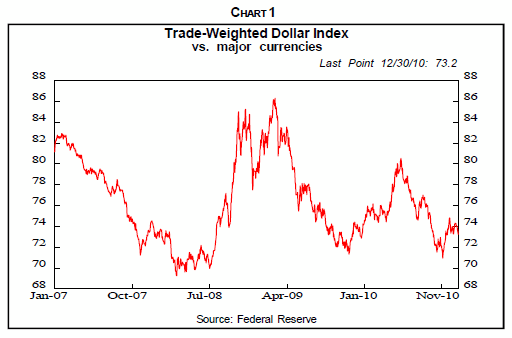
Furthermore, until early 2010, almost everyone was on the dump-the-dollar side of the boat, a situation similar to that early in 2008 that preceded the dollar's jump which started in mid-year (Chart 1). History suggests that when that happens, the winds often shift and all those folks will get tossed into the water as the boat sails in the reverse direction
5. Buy Eurodollar Futures. As we discussed in our Jan. 2010 and Aug. 2010 Insights, in most markets, traders want to be where the action is, where liquidity is the greatest even though that's where competition is the strongest. In the case of short-term credit instruments, it's Eurodollars.
Our interest is in Eurodollar futures contracts based on these deposits. Eurodollar futures are a way for companies and banks to lock in an interest rate today, for money it intends to borrow or lend in the future, and for investors to bet on the future direction of short-term interest rates. Each Eurodollar futures contract has a notional or "face value" of $1 million, though the leverage used in futures allows one contract to be traded with a margin of $500. Trading in Eurodollar futures is extensive, and the market for them tends to be very liquid. The prices of Eurodollars are quite responsive to Fed policy, inflation, and economic indicators. It's ironic that Eurodollar futures markets dominate trading, not those for Treasury bills or federal funds on which Eurodollars are essentially based.
Eurodollar futures prices are determined by the market's forecast of the 3-month US$ London Interbank Offered Rate (LIBOR) the interest rate expected to prevail on the settlement date. Eurodollar futures contracts extend out for 40 quarters or 10 years, so they can be used to bet on interest rate movements many quarters ahead.
Successful
Long positions in Eurodollar futures have been one of our most successful investments in recent years. Earlier, the futures market did not price in the full extent of the Fed-engineered decline in short-term interest rates (Chart 2). With our forecast of the financial crisis and the worst recession since the 1930s, however, we believed that the Fed would ease dramatically. So we reasoned that Eurodollar futures prices would rise as they reflected the Fed's action. And they did.
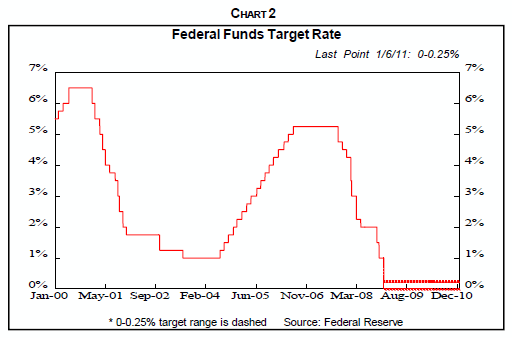
More recently, we were convinced that a weak economy and continuing financial woes would keep the Fed from raising interest rates any time soon -- in contrast to the market's assumption that rate increases were imminent. So in the last several years, Eurodollar futures nine months to a year ahead have been selling at higher interest rates and lower prices than current levels. But with our forecast, we reasoned, prices would rise to current levels when those contracts expire. So far, that has given us excellent returns and we've been rolling expiring contracts into new ones that will expire about a year later.
6. Buy Selected Health Care Providers and Medical Office Buildings. Health care is a huge sector, accounting for 16% of GDP and growing rapidly. Two major features of the current system almost guarantee explosive growth. First, most Americans don't pay directly for their health care, which is financed by employer-sponsored insurance or the government through Medicare and Medicaid. That plus the fact that it's "my life" that's involved means that, except for deductibles and co-pays, there's no restraint on usage. Many participate in what we call "recreational medicine" -- take a day off from work at full pay to visit a physician, at employer expense, because of a minor ailment. Second, in paying for service plans, medical providers have many incentives to perform extra procedures because more office visits enhance their incomes. Defensive medicine with more procedures is also encouraged to avoid litigation over mistakes.
In addition, the demand for medical services in the U.S. will mushroom over coming decades due to several factors:
• Aging Population. Those over 65 have three times as many office visits per year as people under 45, and the oldest of the 78 million postwar babies will reach 65 this year and the youngest in 2029. The government estimates that Medicare and Medicaid expenses will leap from 6.4% of GDP this year to 10.7% in 2029.
• Technological advances are driving patient demand for more medical services.
• 32 million more Americans will be covered by health insurance under the new health care law, an 11% net addition by 2019. The Administration estimates that national health care expenses will rise from $2,632 billion in 2010 to $4,717 billion by 2019, only $46 billion, or 1% higher, than without the new law. But history suggests that the government is underestimating the growth in health care outlays. In 1967, the year after Medicare commenced, the House Ways and Means Committee forecast its cost at $12 billion in 1990. It turned out to be $110 billion -- nine times as much.
• More Jobs. Increased demand for medical services in the years ahead will create jobs, but not enough to absorb all the unemployed in an era of slow economic growth. So Washington may readily accept the creation of more health care jobs than anticipated by the new health care law, ranging from nursing home attendants to brain surgeons. And slow growth and high unemployment will, as usual, encourage the uninsured to join government health programs.
• Little Supply Increase. The new health care law does little to increase the supply of medical personnel and facilities, but booming demand will result in the rapid growth of both, with the latter largely financed by private investments.
• Cost control pressures from government and employers will work to the advantage of big, profitable hospital systems with large campuses and expanding satellite facilities. Renewed growth in cheaper out-patient surgical and other facilities will also be a result of emphasis on cost containment.
• Hospital-employed physicians will increasingly dominate as medical recordkeeping requirements, cost containment pressures from government and insurers, constraints on government reimbursements, expensive new technology, the lack of economies of scale and high practice management costs, and lower incomes relative to hospital-employed physicians weigh on small private practices. Hospitals will also be better able to establish Accountable Care Organizations, authorized by the new law, which allows medical providers to share in cost savings.
• Undocumented immigrants are excluded from health insurance under the new law, so the newly-covered urban poor and the facilities needed to serve them will be most economically efficient in the cities that have fewer undocumented immigrants.
Medical Office Buildings
We also favor investments in medical office buildings (MOBs) that these increases and shifts in demand will require, including related outpatient facilities such as ambulatory care facilities, surgery centers, ambulatory surgical centers, and outpatient cancer and wellness centers. MOB demand is forecast to expand 19% by 2019, 11% of it due to the new law and the rest from population growth. The 64 million square feet are required to meet the demand of the new law and compares with a 2010 build of 7 million square feet. MOBs are much less volatile than other commercial and residential real estate, as shown by more stable vacancy and cap rates. They will not be plagued in future years by persistent excess capacity, which hinders new construction, as is the case with residential real estate, malls and office buildings.
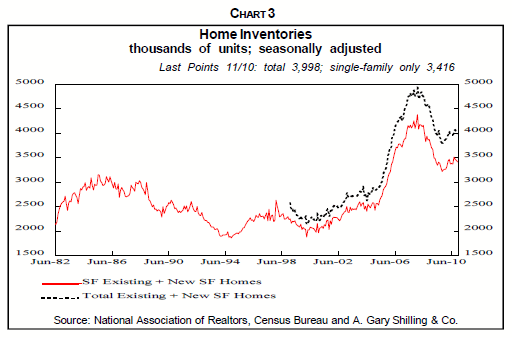
7. Buy Rental Apartments. Rental apartments will benefit from the separation that Americans are beginning to make between their abodes and their investments. The two used to be combined in owner-occupied houses back when owners believed house prices never fall. So they bought the biggest homes they could finance. The collapse in house prices has shown them otherwise. Further weakness in the prices of single-family houses and condos due to the depressing effects of excess inventories (Chart 3) will add fat to the fire. So, too, will further house price weakness even after excess inventories are eliminated due to general deflation. As shown in Chart 4, corrected for the size of houses and inflation/ deflation, single-family house prices have been flat for over a century.
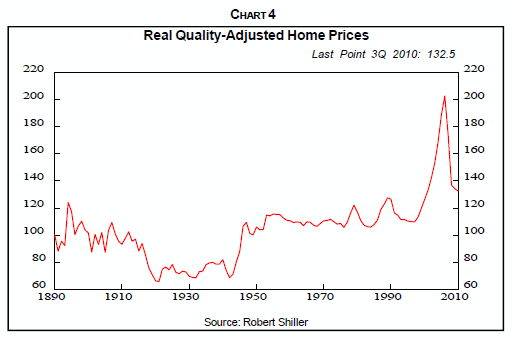
It will take a surprisingly small shift in housing patterns to make a big difference in the demand for and construction of rental apartments. Today, there are 130 million housing units in the United States, of which 36 million are rented. If only 1% of total households decided to move to rentals, the demand for apartments would increase by over one million, most of which would need to be newly built, after current vacancies are absorbed. This is a big number compared to new apartment starts of 333,000 on average over the past 10 years. Rental apartments will also appeal to the growing number of postwar babies as they retire, downsize, and want less responsibility and more leisure time.
8. Buy Productivity Enhancers. In the ongoing slow economic growth, deflationary environment, increased profits through price and volume increases is difficult for many firms. So the current cost-cutting zeal will remain in place. Labor cost-cutting has been in vogue lately, but does have its limits. So anything -- high tech, low tech, no tech -- that helps customers reduce costs and promote productivity will be in demand.
Ironically, the same new technologies that will continue to increase oversupply and promote deflation -- computers, semiconductors, the Internet, biotech, and telecom -- will be in demand to help combat its effects by helping to cut costs. Furthermore, chronic deflation will be a shock to many companies accustomed to operating in inflation, but not to a number of new-tech firms. It isn't a question of whether computer chip prices will fall in any given year, but only by how much.
A basic characteristic of new technology is that it is continually surpassed by newer technology. In deflation, buyers of consumer and capital goods hold off purchases in anticipation of lower prices, and in so doing, force prices lower as excess capacity mounts and undesired inventories pile up. But in areas of rapidly advancing technology, buyers can't wait for lower prices on existing products because they will soon be obsolete. Bear in mind, however, that many big U.S.-based technology companies get major portions of their profits from overseas, and those earnings will be hurt by a chronically rising dollar. Also, their consumer-related business will be subdued by consumer retrenchment, especially if it involves major discretionary purchases.
Cost-cutting also can come from low-tech sources. Outsourcing of call centers as well as information technology (IT) is a case in point. Routine medical and legal work is now being done much more inexpensively in India than in the United States. Temporary help agencies may thrive as companies increasingly curb costs by using temps only at the time of day or season of the year they're needed, and avoid paying high benefit costs.
9. Buy North American Energy. Investments related to North American energy sources should continue to do well. The rationale is simple. The United States is increasingly dependent not on imported energy, especially crude oil. Ditto for petroleum products which follows from local resistance to the construction of new refineries. Import growth over time, of course, has resulted not only from rising demand for oil but also from falling domestic production (Chart 5).
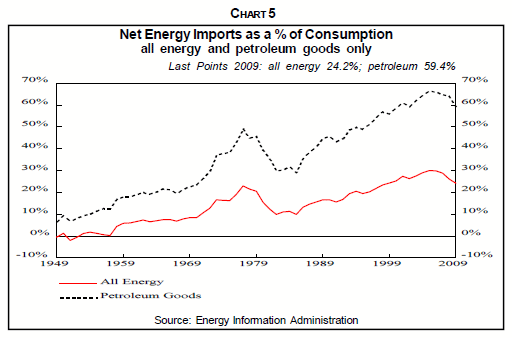
Furthermore, energy imports, especially of crude oil, are coming from a number of countries with military and political instability, including Russia, Iran, Nigeria, and Venezuela. And whether the United States imports oil directly from, say, Iran or not is immaterial. Crude oil is fungible, and supply disruptions in any country are instantly transmitted worldwide.
10. Sell Home Builders and Related Companies. Home building was a growth industry in the salad days of low mortgage rates, lax underwriting standards, securitization of mortgages that passed seemingly creditworthy but in reality toxic assets on to unsuspecting buyers, laissez-faire regulation, and, most of all, conviction that house prices never fall. Now all these conditions have reversed with lending standards tighter, on balance, in part because lenders are being forced to take back bad mortgages. Bank of America just paid Fannie Mae and Freddie Mac $3 billion to cover faulty mortgages it had sold to them and still faces $6 billion in repurchase requests from private mortgage investors.
Furthermore, the securitization of mortgages is essentially dead, with government agencies the only buyers; regulation is much more vigilant; and homeowners are aware that they can lose money, even all of the equity in their highly leveraged houses. Home ownership rates (Chart 6) are falling as those who earlier bought houses to get in on the speculative bonanza are foreclosed out of their abodes, while prospective homeowners wait for still-lower prices.

Conventional home building is likely to be depressed for years. Excess inventories, the residue from the earlier home building boom, have only been partially absorbed despite the collapse in housing starts. New inventory is added as many of the homeowners foreclosed out of their abodes go back to living with parents or with friends, and as owners of investment properties that are empty or rented at below carrying costs give up and dump their houses on the market.
11. If you plan to sell your house, second home or investment houses any time soon, do so yesterday. If we're right and house prices have another 20% to fall over the next several years, this strategy is obvious. Sure, it's tempting to believe that all real estate is local and the only three important factors are location, location, location. But as the decline so far has demonstrated, prices can and have fallen nationwide for the first time since the 1930s. Almost no place in the U.S. was exempt from the sell-off.
12. Sell Selected Big-Ticket Consumer Discretionary Equities. We look for weakness in this sector for several fundamental reasons. Consumers, we believe, are in the midst of a chronic saving spree that will take their saving rate, which fell from 12% in the early 1980s to 0.8% in April 2005 and last November stood at 5.3%, back well into double digits. After the wild volatility and stock losses over the past decade, individuals don't trust their portfolios to put their kids through college and finance early retirement. House price declines have already wiped out the home equity many used to finance oversized spending with more price declines in store.
As they save more and spend less of their median $62,300 household income, overall consumer spending will suffer. In 2008, those age 65 to 74 spent 12.3% less than 10 years earlier in real terms. A recent survey found that only 38% believe they have enough money to retire and of the rest, the biggest number plan to fill the gap by saving more.
Chronically high unemployment is another incentive to save because of the income uncertainty it creates. And the reality that real median household income fell 4.8% between 2000 and 2009 is another wake-up call for saving more and spending less. The need for households to spend less and save more to work down debt, a process barely started, is clear as is the need to rebuild net worth (Chart 7). Furthermore, the high correlation between household debt and personal consumption suggests that the recent strength in spending will be reversed.
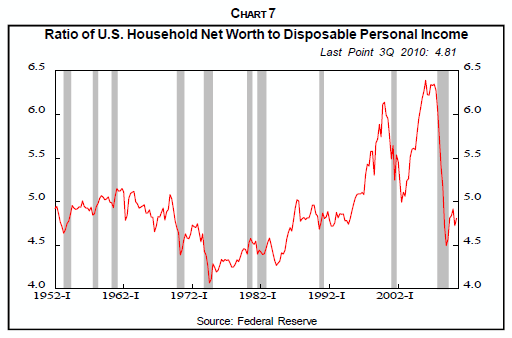
The 9% jump in personal bankruptcies in 2010 from 2009 to 1.53 million, the highest since the law was revised in 2005, says many have been overspending and need to retrench.
No wonder that low-end dollar stores continue to thrive, especially since the number of households with income under $35,000 has jumped by 1.8 million since 2007. They're even attracting thrifty better-off consumers as are second-hand stores that did a thriving business before Christmas in "pre-owned" or "formerly loved" items. Net sales rose 13% in 2010 from 2009, the strongest in five years. Construction of overbuilt full-price malls has almost stopped, and builders are turning their attention to the discount malls favored by thrifty shoppers. And don't forget that the recent leap in energy prices, with regular gasoline now distinctly over $3 per gallon, is nothing more than a tax on consumers that cuts their discretionary income.
13. Sell Consumer Lenders. These stocks bucked the bull market last year and essentially were flat over the course of 2010. We look for further relative and even absolute weakness this year. Since the end of 2008, revolving credit balances (mostly credit card) have fallen by $135 billion to $822 billion as consumers delever and issuers tighten lending standards. Eight million cut up their credit cards and millions more paid down their balance and used cash for purchases. Credit card and other consumer lenders had their heyday during the long consumer borrowing-and-spending spree.
Consumers were trained by the media, retailers, and even the government to believe they deserved instant material gratification. Buy now, put it on the plastic card, and pay later -- much later -- became the norm. And creditworthiness was no problem for credit card issuers and other consumer lenders. They sliced and diced consumers' financial statuses, used sophisticated models to determine payment risks, and charged fees and interest rates to fit any risk category.
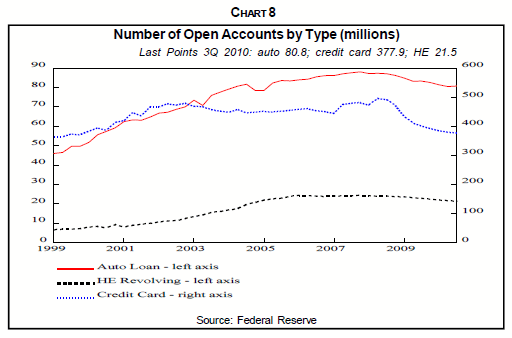
But their models and analyses inherently assumed that the borrowing-and-spending binge, as well as the ability to repay, would last indefinitely. What a revolting development when consumers retrenched and cut back on their use of credit cards! What a surprise it was when consumers suddenly went further and switched to a saving spree and began to pay down credit card and other debt (Charts 8 and 9)! What a shock when heavy layoffs, leaping unemployment, collapsing house prices, and inadequate consumer incomes spiked credit card delinquencies!
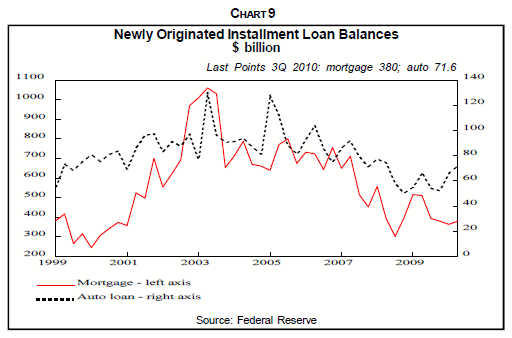
Developments in the past several years are virtually all negative for the credit card business now and will be for years to come. Horror stories abound of people with $20,000 annual incomes who managed to run up $50,000 in credit card debt and then became unemployed. A cottage industry to help these people deal with their financial woes exploded in size. Cash and debit cards are replacing credit cards as consumers realize they can't trust themselves to restrain debt and need to accumulate the money in a bank account before spending it. Layaway plans are replacing the buy now, pay later approach. With the switch from a quarter-century-long consumer borrowing-and-spending binge to a long-run saving spree, the credit card business has moved from a growth industry to a laggard.
14. Sell Medium and Smaller Banks. Smaller bank stocks rose even more than large ones last year but may reverse that performance this year. Ironically, in the go-go days, many of them were unwilling to virtually abandon their underwriting standards to compete with nonbank residential mortgage lenders. So they lent to the commercial real estate market instead, often residential construction-related firms.
Due to bad commercial as well as direct residential real estate loans, smaller banks have been dropping like flies. In 2008, 322 banks with $633.7 billion in total assets failed ($2.0 billion per bank), in 2009, 140 banks with $169.7 billion failed ($1.2 billion per bank) and another 157 with $92.1 billion failed in 2010 ($0.6 billion per bank). So those that have failed have gotten progressively smaller. As of last September 30, the FDIC had 860 banks on its "problem list" with an average of $440 million in assets, so more small bank failures lie ahead. Furthermore, many of the 600 banks that still have TARP money are small, weak institutions that have little access to alternative capital. And most of the 98 banks that got TARP money and are troubled are small ones with bad commercial real estate loans.
The declines in loan charge-offs are slower at small than large banks and many of them continue to add to loan loss reserves while large banks reduce them. Of the nation's 7,830 banks, 91% had assets under $100 million. Not surprisingly, small banks complain that bank examiners are overly conservative, especially in assessing their commercial real estate loans. Individually, they aren't too big to fail, but collectively they are since smaller banks are the primary financers of smaller businesses. Those businesses don't have access to commercial paper and other credit market vehicles and must rely on their local banks for loans -- or on the personal credit cards of their owners.
Commercial banks hold about $1.5 trillion in commercial and multifamily housing debt. They also have around $500 billion in land and construction loans that are especially toxic since raw land and unfinished buildings provide no revenue but incur outlays for taxes, completion of the structures, guarding against vandalism, etc.
From June 2007 through 2008, banks with less than $10 billion in assets bought more than $4 billion in private-label mortgage bonds that are not issued or guaranteed by government agencies. Many of them were downgraded to junk status as homeowner defaults surged. Some of those banks believe the bonds will eventually pay off, but regulators forced them to reserve extra capital against likely losses.
The Achilles heel for medium and small banks is their troubled commercial real estate loans. Many more are likely to fail as those loans mature in the next several years.
15. Sell Junk Securities. During the dark days of the financial crisis, the yields on junk bonds leaped to 19.3 percentage points over Treasurys as investors worried about complete financial collapse and widespread defaults among low-grade issues. Triple-C rated bonds, the lowest junk tier, sold at 42.6 cents on the dollar at the beginning of 2009, and yielded 44.3 percentage points over Treasurys in December 2008.
But the bailout of the big banks and easing of the financial crisis allayed investor fears, and junk spreads collapsed to levels lower than in many pre-financial crisis years. Institutional investors piled in, followed by individual investors, many of whom sought alternatives to low returns on bank deposits and money market funds and who also bought investment-grade corporate and municipal bonds.
So the spreads on junk bonds collapsed and in 2009, junk bonds returned 57% and low-quality leveraged loans returned 52%, much more than the 24% gain on the S&P 500 Index, despite the fact that 11% of junk issuers defaulted that year. Some 265 companies defaulted on bonds, double the 2008 tally and more than the previous high of 229 in 2001. In 2010, contrary to our expectation, junk bonds rose another 13% in price as the default rate dropped to 1.1%.
In any event, we believe this rally was way overdone. In addition, the slow economic- growth, deflationary scenario we project this year and beyond will be lethal for many junk bonds, both those issued as high-yield instruments by companies with shaky balance sheets and fallen angels that have been downgraded to junk status. Slow revenue and cash flow growth, to say nothing of deflation, will make it difficult if not impossible for a number of financially weak and weakening firms to service their bonds and other debts as the principals of those instruments rise in real terms.
16. Sell Developing Country Stocks and Bonds. Developing country stocks and bonds rose last year, but we doubt those gains will persist. Most of those countries depend on exports for growth, a major part of which were bought by U.S. consumers in earlier years. But American consumers, in our judgment, are in the midst of a chronic saving spree that will curtail our imports and, in turn, overseas economies' exports and economic gains.
Notice the effects of American consumer retrenchment and global weakness on Chinese exports in recent years (Chart 10), which broke the strong uptrend as a share of GDP. Notice also the declining and low share going to consumption, a mere 34% in 2009. This is well below G-7 countries or even India with 56%. China and others want to develop domestic-led economies, but are years away from lowering their high and rising saving rates and making other changes needed to spur their domestic economies. With no meaningful equivalent of Social Security retirement benefits and Medicare, Chinese need to save for their retirement and medical care.
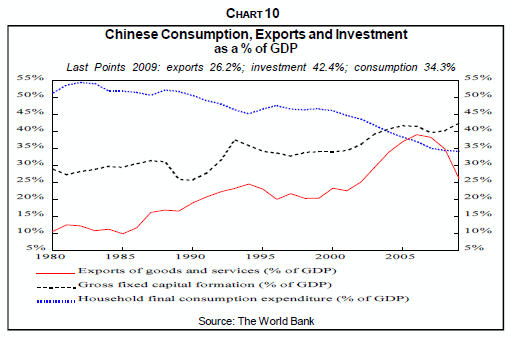
Further, in the case of China, the stop-go economic policy is in the stop phase after the massive $585 billion stimulus program of 2009. She is trying to curb the resulting property market bubble and inflation by raising reserve requirements and interest rate, limitations on bank lending, controls on real estate and other means. Give the crudeness of her economic policy tools and the part-controlled, part-market driven nature of her economy, we believe a hard landing this year will result and GDP growth will plummet to recessionary 6% or so levels. This will be the shot heard 'round the world, especially by those who have the same shock and awe over China that they had for Japan in the late 1980s, right before her real estate and stock bubbles broke and she entered two decades of deflationary depression that still persists. It will also again end the decoupling myth that says developing countries can grow rapidly, independent of advanced lands to whom they export.
17. Sell Selected Commodities. We believe that a full-blown commodity bubble had developed. The recent shortages of hard rock miners for copper and other metals is one more signal of a top in the commodity boom. A hard landing in China may well be the pin that pricks that bubble. Not only has she been a gigantic importer of coal, iron ore, nonferrous metal, resins, crude oil and other industrial materials both for current production and for stockpiles, but psychologically China is considered the center of global industrial production.
Any hint of a hard landing there will no doubt drop the scales from speculators' eyes and industrial commodity prices, including copper, will swoon. So, too, will the currencies of commodity producers such as Australia, New Zealand and Canada. And the strong dollar we're predicting will work to depress commodity prices, especially the many globally-traded ones such as oil that are priced in dollars.
We're recommending sales of selected commodities because agricultural producers are influenced by global demand but also by weather-driven supply. Forecasting economies is tough enough, so we'll leave it to others to forecast the weather. Note, however, that in the past, ideal growing weather often follows the bad weather suffered lately, and bumper crops and surpluses often replace hand-wringing shortages in a crop year or two.
18. Sell Many Old Tech Capital Equipment Producers. Our eighth investment strategy for this year, Buy Productivity Enhancers, includes many new tech companies. Nevertheless, old tech outfits are in a different atmosphere, in our judgment. True, their stocks did well in 2010, rising from their recessionary ashes to climb about three times as much as the SP 500, contrary to our forecast. This year, we're renewing our forecast of weakness. We expect a hard landing in China to end the boom abroad and once again assert the dependence of many of those countries on now-retrenching U.S. consumers.
In the U.S., many expect the atmosphere of higher profits and piles of corporate cash will unleash a bonanza in capital equipment spending, reversing the recent leveling and decline in growth rates. Our analysis suggests otherwise. When operating rates are low, as at present, producers don't need more capacity and worry that revenues, prices, and profits won't be adequate to justify even existing capacity. Besides the depressing effects of excess capacity, low-tech and old-tech companies suffer from other ongoing problems. Foreign competition continues to grow as their technology is transferred to China and other cheap production locales. Some suffer rising cost pressures due to lack of productivity gains. High-cost labor forces are sometimes a problem. And many sell into saturated, slow growth markets.
John F. Mauldin
johnmauldin@investorsinsight.com
John Mauldin, Best-Selling author and recognized financial expert, is also editor of the free Thoughts From the Frontline that goes to over 1 million readers each week. For more information on John or his FREE weekly economic letter go to: http://www.frontlinethoughts.com/learnmore
To subscribe to John Mauldin's E-Letter please click here:http://www.frontlinethoughts.com/subscribe.asp
Copyright 2011 John Mauldin. All Rights Reserved
Note: John Mauldin is the President of Millennium Wave Advisors, LLC (MWA), which is an investment advisory firm registered with multiple states. John Mauldin is a registered representative of Millennium Wave Securities, LLC, (MWS), an FINRA registered broker-dealer. MWS is also a Commodity Pool Operator (CPO) and a Commodity Trading Advisor (CTA) registered with the CFTC, as well as an Introducing Broker (IB). Millennium Wave Investments is a dba of MWA LLC and MWS LLC. Millennium Wave Investments cooperates in the consulting on and marketing of private investment offerings with other independent firms such as Altegris Investments; Absolute Return Partners, LLP; Plexus Asset Management; Fynn Capital; and Nicola Wealth Management. Funds recommended by Mauldin may pay a portion of their fees to these independent firms, who will share 1/3 of those fees with MWS and thus with Mauldin. Any views expressed herein are provided for information purposes only and should not be construed in any way as an offer, an endorsement, or inducement to invest with any CTA, fund, or program mentioned here or elsewhere. Before seeking any advisor's services or making an investment in a fund, investors must read and examine thoroughly the respective disclosure document or offering memorandum. Since these firms and Mauldin receive fees from the funds they recommend/market, they only recommend/market products with which they have been able to negotiate fee arrangements.
Opinions expressed in these reports may change without prior notice. John Mauldin and/or the staffs at Millennium Wave Advisors, LLC and InvestorsInsight Publishing, Inc. ("InvestorsInsight") may or may not have investments in any funds cited above.
Disclaimer PAST RESULTS ARE NOT INDICATIVE OF FUTURE RESULTS. THERE IS RISK OF LOSS AS WELL AS THE OPPORTUNITY FOR GAIN WHEN INVESTING IN MANAGED FUNDS. WHEN CONSIDERING ALTERNATIVE INVESTMENTS, INCLUDING HEDGE FUNDS, YOU SHOULD CONSIDER VARIOUS RISKS INCLUDING THE FACT THAT SOME PRODUCTS: OFTEN ENGAGE IN LEVERAGING AND OTHER SPECULATIVE INVESTMENT PRACTICES THAT MAY INCREASE THE RISK OF INVESTMENT LOSS, CAN BE ILLIQUID, ARE NOT REQUIRED TO PROVIDE PERIODIC PRICING OR VALUATION INFORMATION TO INVESTORS, MAY INVOLVE COMPLEX TAX STRUCTURES AND DELAYS IN DISTRIBUTING IMPORTANT TAX INFORMATION, ARE NOT SUBJECT TO THE SAME REGULATORY REQUIREMENTS AS MUTUAL FUNDS, OFTEN CHARGE HIGH FEES, AND IN MANY CASES THE UNDERLYING INVESTMENTS ARE NOT TRANSPARENT AND ARE KNOWN ONLY TO THE INVESTMENT MANAGER.
John Mauldin Archive |
© 2005-2022 http://www.MarketOracle.co.uk - The Market Oracle is a FREE Daily Financial Markets Analysis & Forecasting online publication.



